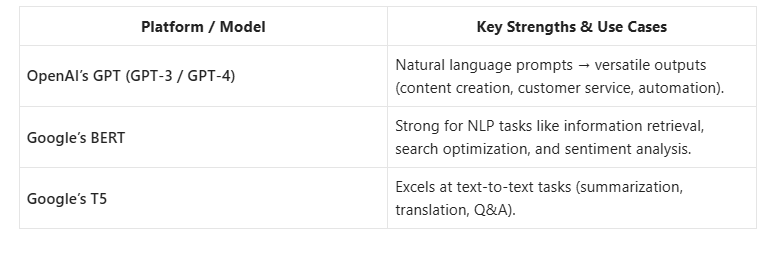Introduction to Prompt Engineering
In the rapidly evolving field of artificial intelligence (AI), prompt engineering has emerged as a key skill. But what exactly is prompt engineering, and why is it so important in today’s tech-driven world? In simple terms, prompt engineering is the art of crafting the right prompts or inputs to guide an AI model towards generating the most accurate and useful responses. Unlike traditional programming, this skill does not require any coding experience, making it accessible to a broader range of people interested in using AI tools without needing a deep technical background.
Why Prompt Engineering Matters
The Power of Well-Crafted Prompts
Prompt engineering is at the heart of effective AI interaction. A well-constructed prompt can dramatically enhance the quality of an AI’s output, whether you’re using a language model for content generation, decision-making, or automation tasks. The goal is to create a query that leads to the most relevant and valuable response, thus optimizing the performance of AI tools.
The Rise of AI Tools in Modern Times
With the rise of advanced AI tools like GPT, BERT, and other machine learning models, users can now interact with AI without needing any knowledge of coding. This revolution has shifted the balance, allowing individuals from diverse fields-business, marketing, education, and even creative industries-to leverage AI to solve real-world problems.
The Importance of User Interaction
The quality of an AI model’s output is directly influenced by the clarity and quality of the prompt given. By understanding how to create precise and thoughtful prompts, users can ensure that AI tools understand the context and produce the best results.
Key Principles of Prompt Engineering
Understanding the Basics of Crafting Effective Prompts
Effective prompt engineering revolves around a few key principles that can significantly improve AI performance. Let’s explore some of the most important concepts:
Clarity and Precision in Prompts
When creating prompts for AI models, being specific is vital. A vague or ambiguous prompt will lead to unsatisfactory or irrelevant results. For instance, asking “What is the weather?” could yield a broad, useless answer, while “What is the weather forecast for New York City today?” will lead to a much more targeted and useful response.
Language and Structure
The structure of the prompt also plays a crucial role. Clear and concise language that includes necessary context ensures the AI can understand the query. Additionally, breaking down complex requests into simpler, smaller parts can make the prompt easier for AI to process.
Common Mistakes to Avoid in Prompt Engineering
While prompt engineering is accessible, there are common mistakes that beginners should avoid:
Lack of Context
One of the most common mistakes is neglecting to provide sufficient context in the prompt. AI models rely on context to generate relevant answers. For example, if you ask, “What is the fastest animal?” without specifying the type of environment (land, water, air), the answer could vary widely.
Overcomplicating Prompts
Another pitfall is overloading the AI with too much information. While detailed prompts can be effective, overly complex queries may confuse the AI, leading to imprecise or contradictory answers. Keep prompts as simple and clear as possible while still providing necessary details.
The Role of Artificial Intelligence in Prompt Engineering
How AI Understands and Responds to Prompts
AI models like GPT and BERT use complex algorithms to process language and generate responses. By breaking down the user input, AI understands the intent behind the prompt and structures its output accordingly. Prompt engineering helps fine-tune this process by directing the AI to focus on specific areas of interest, producing more accurate and relevant responses.
The Evolution of AI in Prompt Response
AI models have evolved from basic systems that only understood simple queries to sophisticated, multi-layered platforms capable of handling complex and nuanced prompts. The development of large language models has made it easier for non-technical users to interact with AI and achieve powerful results.
Using AI Tools Without Coding
One of the most exciting aspects of modern AI is that it allows people without coding knowledge to use these tools effectively. Platforms like OpenAI’s GPT models, as well as other no-code tools, enable users to create detailed prompts and generate sophisticated responses without writing a single line of code.
Tools and Platforms for Prompt Engineering

Best No-Code Platforms for Crafting Prompts
There are several no-code platforms available for prompt engineering. These tools are designed for non-technical users and allow them to craft powerful prompts to generate custom outputs from AI models.
OpenAI’s GPT Models
OpenAI’s GPT models are widely regarded as some of the most powerful tools for prompt engineering. With GPT-3 and GPT-4, users can input natural language prompts and receive highly accurate responses that can be used for a variety of purposes, from content creation to customer service automation.
Google’s BERT and Other Alternatives
In addition to GPT, other models like Google’s BERT and T5 have also gained popularity in the field of natural language processing (NLP). These tools provide users with advanced capabilities for prompt engineering and are useful for applications ranging from information retrieval to sentiment analysis.
Testing and Refining Prompts
How to Test and Improve Your Prompts
Once you’ve crafted a prompt, testing it is crucial. It’s essential to observe how the AI responds and adjust the prompt accordingly to improve accuracy and relevance.
Iterative Testing
The process of prompt refinement is ongoing. After testing your prompt, you may notice areas where the AI’s response could be improved. By iterating on the prompt-adjusting language, structure, or adding more context-you can gradually enhance the results.
Understanding AI Feedback
AI feedback refers to the outputs or responses given by the AI based on your prompt. By analyzing these responses, you can determine what works and what needs to be changed. Understanding how AI interprets your prompts allows you to refine them further for better results.
Real-World Applications of Prompt Engineering
| Industry | Applications |
|---|---|
| Business & Marketing | Automates content creation, customer service, and market research through precise prompts. |
| Education & Research | Enables personalized learning, dataset analysis, and creation of custom quizzes or modules. |
How Prompt Engineering is Used Across Industries
Prompt engineering is transforming a variety of industries by enabling the automation of processes and improving AI accuracy in areas like content creation, customer support, and research.
Business and Marketing
In business, prompt engineering is often used to automate content generation, customer service interactions, and even market research. By providing well-crafted prompts, businesses can streamline their operations and provide faster, more accurate responses to customers.
Education and Research
In education, prompt engineering is becoming an essential tool for personalized learning. Teachers and researchers can use AI to generate custom materials, analyze large datasets, and even create quizzes or learning modules that suit specific learning needs.
Future Trends in Prompt Engineering
What’s Next for the Future of AI and Prompts?
Looking ahead, the field of prompt engineering is expected to continue growing, with more tools and platforms emerging to support non-technical users. As AI models become even more advanced, the ability to craft highly personalized and context-aware prompts will become a critical skill for anyone working with AI.
Personalized AI Responses
One future trend is the shift towards more personalized AI responses. As AI becomes better at understanding individual user preferences and needs, prompt engineering will play a key role in tailoring interactions to maximize relevance and accuracy.
The Growing Role of No-Code Platforms
No-code platforms will continue to grow in popularity, allowing more individuals and organizations to benefit from AI without requiring technical expertise. These platforms are likely to offer even more advanced capabilities in the near future, making prompt engineering accessible to a wider audience.
Conclusion
Wrapping Up: Mastering Prompt Engineering Without Code
Prompt engineering is an incredibly valuable skill that doesn’t require coding knowledge. By understanding the principles behind crafting effective prompts, anyone can improve their interactions with AI tools and harness the power of artificial intelligence for various applications. Whether you’re working in business, education, or another field, mastering prompt engineering will give you a competitive edge in today’s tech-driven world.
FAQs
- What is prompt engineering?
Prompt engineering is the practice of creating well-structured prompts to guide AI models in generating relevant and accurate responses without the need for coding. - Why is prompt engineering important?
Effective prompt engineering helps AI models understand user queries better, resulting in higher-quality and more precise outputs. - Can I use AI tools without knowing how to code?
Yes, many no-code platforms allow users to interact with AI models, create custom prompts, and get results without any programming knowledge. - What are some common mistakes in prompt engineering?
Common mistakes include providing insufficient context, overcomplicating prompts, and being vague with the language. - What are some tools for prompt engineering?
Popular tools for prompt engineering include OpenAI’s GPT models, Google’s BERT, and other no-code platforms that allow users to create and refine prompts. - How can I improve my prompts?
Testing your prompts iteratively, adding relevant context, and analyzing AI feedback will help you improve your prompts for better results.
